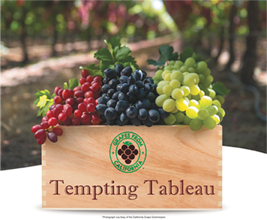Although grapes have been cultivated for thousands of years, if there was ever a region ideally suited to growing the luscious globes—for wine, raisins, or to enjoy fresh—it’s California. From Spanish missions in the 1700s to William Wolfskill’s Los Angeles area vineyards in the 1800s, the Golden State’s location and sublime growing conditions have proven indispensable to the table grape industry.
Today, 99 percent of the table grapes produced in the United States are grown in California, mainly in the Coachella and San Joaquin Valleys. Grapes for raisins, juice, and to some degree those destined to become wine, are grown in these regions as well.
John V. Zaninovich, president of Vincent B. Zaninovich & Sons, Inc. in Richgrove, CA explains, “Climate, soil, and California’s natural barriers all contribute to perfect conditions for growing table grapes. Coachella Valley, where the season’s first grapes are ready by early May, is hot and dry most of the year. The San Joaquin Valley basin, where the harvest starts in June, protects the grapes from coastal moisture and fog. You need a long, dry growing season. Rain is the enemy of mature grapes.”
The fact that both valleys experience extreme temperatures also contributes to the quality of the table grapes grown there. John Harley, vice president of sales and marketing at Anthony Vineyards, Inc. in Bakersfield, clarifies: “The cold temperatures in the winter allow the vines to go dormant, giving them ample rest after they’ve been pruned. In Coachella Valley, the soil is rockier, it gets hot sooner and the season is shorter with harvest in April and May. In Kern County, the climate is more Mediterranean and the harvest season is generally June through October.”
While the Napa, Mendocino, and Sonoma valleys with their varied microclimates are famous for wine grapes, the finest table grapes come primarily from the Coachella Valley and the Southern end of the San Joaquin or Central Valley. “Table grapes require more exacting conditions and growing techniques,” Harley says. “A weather-related disaster will turn table grapes into candidates for raisins or juice.”
Industry Profile
Although China is the world’s top table grape producer in terms of volume (9 billion tons), the United States is still a major player in the worldwide grape trade. The United States ranks sixth according to the U.S. Department of Agriculture, behind Turkey, the European Union, Brazil, and Chile, while both Peru and Mexico are gaining ground in terms of acreage and production value.
Bringing in nearly $5 billion annually, grapes of all varieties are California’s highest value crop. Kathleen Nave, president of the California Table Grape Commission, says 2014 was the second highest volume year ever for the state’s fresh grape growers. “There are 475 table grape growing operations on 100,000 acres of California land,” she says, explaining that the 2013 season’s 116.2 million 19-pound boxes of table grapes was a record, and 2014 was close behind at 110 million boxes. “Call it the new normal,” she enthuses.



